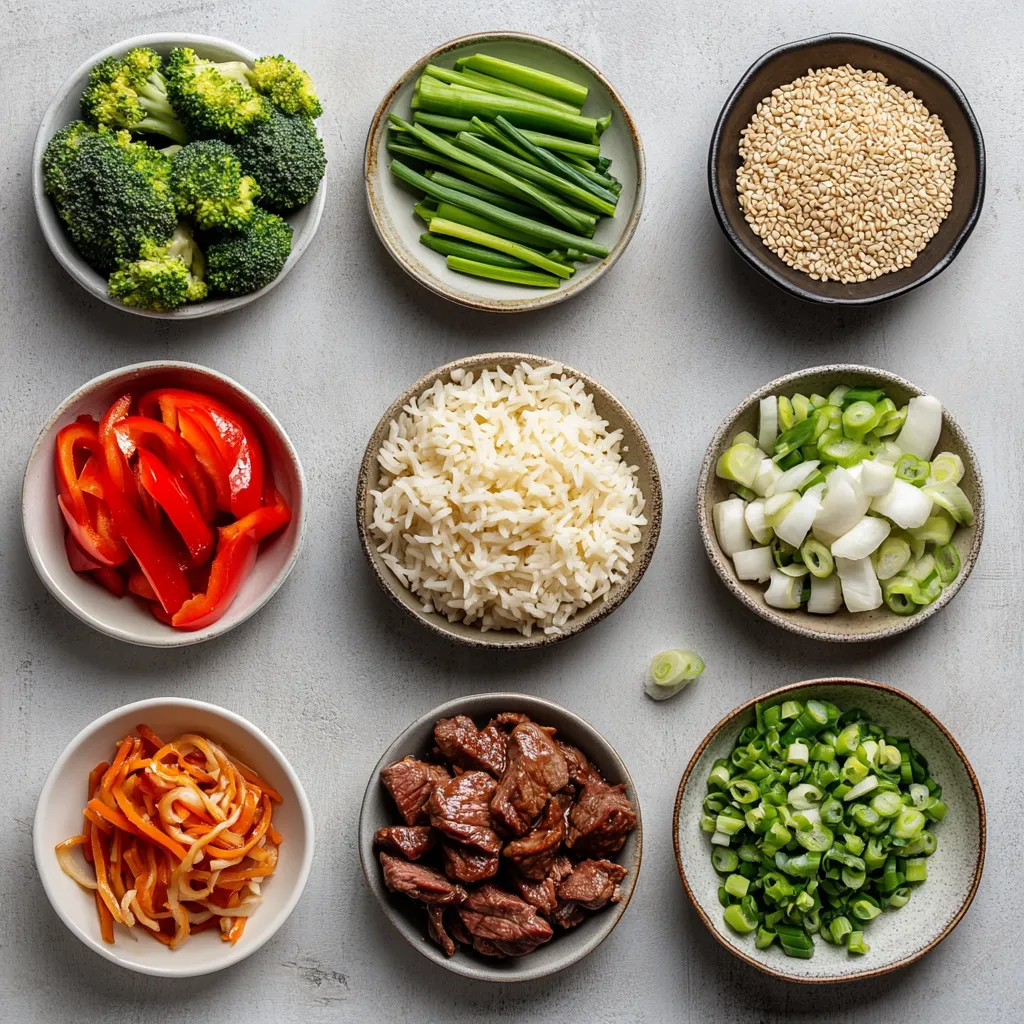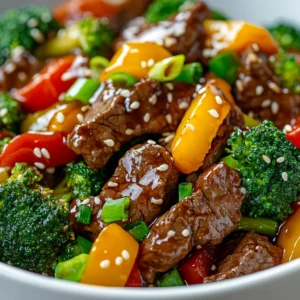Introduction
Exploring the delightful world of quick and flavorful meals, One-Pan Chinese Beef and Broccoli Sensation stands out as a must-try recipe for busy weeknights. This dish marries tender flank steak with crunchy fresh vegetables, all enveloped in a savory sauce that’s both satisfying and nutritious. With a cooking time of just 30 minutes, it brings the essence of Asian cuisine right to your kitchen, allowing you to enjoy a restaurant-quality meal without the wait.
The harmonious blend of savory flavors and vibrant colors makes this dish not only delicious but visually appealing as well. The balance of juicy flank steak with fresh broccoli and bell peppers results in an exciting combination of textures, while the flavorful marinade infuses the meat with depth and enhances your palate experience. Ideal for family dinners or gatherings with friends, this One-Pan Chinese Beef and Broccoli Sensation is versatile enough to adapt to everyone’s taste preferences.
Recipe Overview
– Total Time: 30 minutes
– Prep Time: 15 minutes
– Cook Time: Not specified in the recipe.
– Yield/Servings: 4 servings
– Difficulty: Not specified in the recipe.
This recipe revolves around a single pan, making it an ideal choice for those who want to minimize cleanup while unleashing incredible flavors. The use of flank steak not only ensures tenderness but also absorbs the rich marinade, enhancing the overall taste. Fresh broccoli and colorful bell peppers contribute both texture and nutritional value, culminating in a vibrant dish that’s perfect for any occasion.
Ingredients
– 1 lb (450g) flank steak, thinly sliced against the grain
– 2 cups fresh broccoli florets
– 1 cup bell peppers, sliced (choose red or yellow for vibrant color)
– 3 cloves garlic, finely minced
– 1-inch piece of ginger, freshly grated
– 1/4 cup soy sauce
– 2 tablespoons oyster sauce
– 1 tablespoon cornstarch
– 2 tablespoons vegetable oil
– 1 tablespoon sesame oil
– 1 tablespoon rice vinegar
– 1 teaspoon sugar
– 1/4 teaspoon freshly ground black pepper
– Cooked rice or noodles, for serving
– Sesame seeds and sliced green onions, for garnish

Instructions
1. Marinate the Beef: In a mixing bowl, combine the thinly sliced flank steak with soy sauce, oyster sauce, cornstarch, sugar, and black pepper. Stir well to ensure the beef is evenly coated. Allow it to marinate for a minimum of 15 minutes while you prep the vegetables.
2. Prepare the Vegetables: Rinse the broccoli florets under cold water and cut them into bite-sized pieces. Slice the bell peppers into thin strips, and finely mince the garlic and ginger. Set all prepared vegetables aside.
3. Cook the Beef: Heat the vegetable oil in a large skillet or wok over medium-high heat. Once the oil is shimmering, add the marinated beef in a single layer. Sear the beef for about 2-3 minutes until it develops a nice brown crust. Remove the beef from the pan and set it aside on a plate.
4. Stir-Fry the Vegetables: In the same pan, add a splash more oil if needed, then introduce the minced garlic and grated ginger. Stir-fry for approximately 30 seconds until aromatic. Add the broccoli florets and sliced bell peppers, and continue to stir-fry for about 3-4 minutes until the vegetables are tender yet still crisp.
5. Combine Everything: Return the cooked beef to the pan with the sautéed vegetables. Drizzle sesame oil and rice vinegar over the mixture, stirring everything together until heated through, about 2 minutes.
6. Serve: Serve this delightful beef and broccoli stir-fry over a bed of warm cooked rice or noodles. For an appealing finish, sprinkle sesame seeds and sliced green onions on top for added flavor and a pop of color.
Marinating the Beef
– Importance of Marinating: Marinating beef is essential for enhancing its flavor and ensuring tenderness. A well-crafted marinade can penetrate the meat, adding depth and complexity, which is especially vital for tougher cuts like flank steak.
– Ingredients for Marinade: The marinade for this dish is composed of soy sauce, oyster sauce, cornstarch, sugar, and black pepper. Each ingredient plays a specific role—soy sauce provides umami, oyster sauce adds a rich sweetness, and cornstarch serves to tenderize the meat while creating a velvety texture once cooked.
– Tips for Effective Marination: For optimal results, allow the flank steak to marinate for at least 15 minutes, though extending this period can intensify the flavor. Ensure that each slice is adequately coated by mixing thoroughly in the bowl. Covering the bowl or transferring the steak to a resealable bag can also aid in even marination.
Preparing the Vegetables
– Selecting the Right Vegetables: Fresh produce is key in elevating this dish’s nutritional value and taste. Broccoli provides essential vitamins and adds a satisfying crunch, while vibrant bell peppers contribute sweetness and color.
– Preparation Techniques: Start by rinsing the broccoli florets under cold water to remove any residual dirt. Cutting them into bite-sized pieces not only facilitates easier eating but also ensures even cooking, allowing them to remain crisp yet tender.
– Mince Garlic and Grate Ginger: For the aromatics, use a sharp knife to finely mince the garlic and a microplane to grate the ginger. Mincing garlic releases its natural oils, intensifying its flavor, while grating ginger incorporates its warm spiciness into the dish seamlessly, ensuring an aromatic base that complements the beef and vegetables.
Cooking the Beef
– Heating the Pan: Properly heating the pan is crucial for achieving the perfect sear on the beef. When the vegetable oil is shimmering, it’s a sign that the pan has reached the right temperature. Cooking the beef in a single layer will allow it to sear rather than steam, resulting in a beautifully browned exterior that enhances flavor and texture.
As the beef cooks, the marinade will bubble and thicken slightly, contributing to a delightful glaze that clings to the meat. Once browned, it’s essential to remove the beef from the pan to prevent overcooking, as it will continue to cook slightly when mixed with the vegetables later. This technique ensures that the beef remains tender and juicy, a hallmark of this One-Pan Chinese Beef and Broccoli Sensation.

Importance of oil temperature
The temperature of the oil plays a pivotal role in achieving the perfect stir-fry results. Oil that is heated adequately ensures that the beef sears instead of stewing, which can lead to overcooking. For this recipe, the oil should be shimmeringly hot before the beef is added. This high temperature allows the beef to cook quickly, locking in juices and flavor while preventing it from becoming tough.
Best pan types for stir-frying
Using the right pan can significantly impact the cooking process. A heavy-duty wok or a large, non-stick skillet is ideal for stir-frying due to their capacity to withstand high heat and distribute it evenly. Woks allow for a larger cooking surface, making it easier to toss the ingredients, while non-stick skillets prevent food from sticking, ensuring a beautiful presentation.
Searing the Beef
Searing is a key technique that introduces depth and richness to the flavor profile of your dish. When the beef slices are added to the pan, the intense heat results in the Maillard reaction, which creates that coveted brown crust. To achieve this, ensure that the beef is spread evenly in a single layer without overcrowding; otherwise, it will steam rather than sear.
Techniques to achieve a brown crust
To attain a golden-brown crust, it’s critical to not flip the beef slices too soon. Allow the first side to sear undisturbed for at least 2-3 minutes. This time frame allows for caramelization. Once you notice a rich brown color on one side, flip the slices over for an additional minute or so to enhance the crust’s flavor.
Timing for perfect sear
The timing of the sear is crucial. Depending on your stove’s heat settings and the thickness of your beef slices, aim for 2-3 minutes on each side. Monitor the color closely. If the beef begins to blacken rather than brown, lower the heat slightly. Remove the beef when it’s well-seared but still tender, ensuring it will finish cooking later with the vegetables.
Removing the Beef
Once seared, the beef should be removed from the pan promptly. Leaving it in the pan will continue to cook it due to residual heat. Transferring the beef to a plate helps it to rest, locking in moisture for a juicy texture.
How to ensure it doesn’t overcook
To prevent the beef from overcooking while you prepare the vegetables, ensure you maintain a quick cooking pace. Keep the heat high when stir-frying vegetables to ensure that everything cooks rapidly yet harmoniously. Once the beef goes back into the pan, mixing with the vegetable stir-fry for just a couple of minutes will ensure it is heated through without overcooking.
Stir-Frying the Vegetables
Aroma Building
Adding the minced garlic and grated ginger to the hot oil not only enhances the aroma but also infuses flavors into the oil, which will coat the vegetables as they cook. A frying pan with marginal amounts of oil will help to keep the pungent flavor of garlic and ginger from becoming bitter by cooling them down too soon.
Adding garlic and ginger
These aromatics should be cooked for about 30 seconds to allow their flavors to develop fully. Watch carefully for browning; you want them golden and fragrant, not burnt.
Signs of readiness
You can tell when the base layer of garlic and ginger is ready by its rich aroma and slight color change, usually a golden hue. This is your cue to add the bulk of the vegetables quickly, maintaining the heat to prevent burning.
Cooking Broccoli and Bell Peppers
To achieve the perfect texture for the vegetables, broccoli florets should be added first, followed by bell peppers. Broccoli takes a little longer to cook through, and bell peppers should retain a slight crunch.
Ideal cooking times for texture
Stir-fry the broccoli for about 2-3 minutes to maintain its vibrant green color and crispness. When adding bell peppers, an additional 2 minutes will help them soften slightly while preserving their bright appearance and sweet flavor.
Tips for maintaining crunch
To preserve the crunchiness of your vegetables, constantly stir them while cooking and keep the heat high. Avoid covering the pan, as this will trap steam and make the veggies soggy.
Combining Ingredients
Adding Beef Back to the Pan
When adding the seared beef back to the pan, do this shortly after the veggies are nearly finished cooking to ensure that all ingredients are heated thoroughly at the same time.
Timing and temperature considerations
Ensure the heat is still set to high while mixing the beef and vegetables. This will allow the sauce to quickly coat everything without steaming the ingredients.
Drizzling Sauces
Once the beef is reintroduced to the pan, drizzle the sesame oil and rice vinegar over the entire mixture. This technique allows the flavors to meld beautifully while preserving the fresh taste of the vegetables.
Role of sesame oil and rice vinegar
Sesame oil contributes a distinctive nutty flavor, while rice vinegar adds a subtle tanginess. When blended together, they balance the dish’s flavors, enhancing both the beef and the crisp vegetables.
Balancing flavors in the final mix
Toss everything gently to ensure an even distribution of flavors and to prevent the vegetables from becoming overly soft. A quick stir just until heated through is all that’s required.
Serving Suggestions
Choosing the Right Base
Choosing between rice and noodles as a base can depend on personal preference. Rice offers a milder flavor that provides a nice backdrop for the richness of the beef and sauce, while noodles add a delightful chewiness that can complement the dish.
Options of rice vs. noodles
White rice, brown rice, or even jasmine rice can work beautifully. If opting for noodles, consider hoisin or soba noodles for added flavor and texture.
Presentation Ideas
For an appealing presentation, serve the stir-fry in shallow bowls, which allows for the vibrant color of the dish to shine. Layer the rice or noodles first, then top generously with the beef and vegetable mixture.
Tips for an appealing plate
Enhance your presentation further by garnishers such as additional sesame seeds and sliced green onions. This not only adds visual appeal but also heightens flavor.
Garnishing with sesame seeds and green onions
Sprinkling sesame seeds over the finished dish introduces a crunchy texture that contrasts nicely with tender pieces of beef, and the green onions provide a fresh, bright taste.
Nutritional Benefits
Protein from Flank Steak
Flank steak is a lean cut of beef, providing a substantial amount of protein, essential for muscle building and repair. It is also low in fat, making it a healthier option compared to other cuts.
Vitamins from Vegetables
The colorful array of vegetables provides a wealth of vitamins and minerals. Broccoli is high in Vitamin C and fiber, while bell peppers are rich in antioxidants and Vitamins A and E.
Impact of broccoli
Broccoli stands out for its high levels of sulforaphane, a compound linked to various health benefits, including cancer prevention and improved heart health.
Nutritional value of bell peppers
Bell peppers, especially red and yellow ones, are amongst the richest sources of Vitamin C, essential for boosting the immune system and aiding collagen production.
Healthier Cooking Methods
Stir-frying vs. deep frying
Stir-frying uses significantly less oil than deep frying, making it a healthier option for preparing meals. The quick cooking process helps retain nutrients that can be lost in longer cooking methods.
Variations and Customizations
Adjusting Spice Levels
For those who enjoy a bit of heat, adding chili flakes or a dash of sriracha can bring an exciting kick to the dish. Adjust based on personal preference for a customizable flavor profile.
Adding chili flakes
Incorporate a pinch during the stir-frying phase for a milder spiciness, or increase the amount for more heat, ensuring you balance it with the sweetness of the other ingredients.
Alternative Vegetables
Feel free to experiment with other vegetables based on seasonal availability. Baby corn, snap peas, or bok choy can be excellent additions to diversify flavor and texture.
Suggestions for different stir-fried veggies
Opt for vibrant vegetables like carrots, green beans, or zucchini to maintain visual appeal while enriching the dish.
Making it Vegetarian
Substitute options for flank steak
By replacing flank steak with tofu or tempeh, the dish can easily be transformed into a vegetarian equivalent. Preserving the marinade essence will still deliver a delicious result.
Storing and Reheating Leftovers
Best Practices for Storage
Store any leftovers in airtight containers to keep them fresh. This dish is best consumed within 3 days to maintain its taste and texture.
Airtight containers
Use glass or BPA-free plastic containers to keep the stir-fry safely stored. Ensure they are sealed tightly to prevent air from degrading the food quality.
Reheating Methods
While reheating can be done in a microwave, a stovetop option is preferable for even reheating. This method helps to restore some of the texture that may be lost during microwaving.
Stovetop vs. microwave
In a stovetop pan over medium heat, stir the leftovers frequently. This allows for the ingredients to warm up evenly while preventing the broccoli from turning mushy.
Maintaining texture
To avoid sogginess, consider adding a few drops of water while reheating on the stovetop to create steam, aiding in even heating while keeping the vegetables intact.
Timing and Preparation
Breaking Down the Breakdown
Preparation includes pre-cooking tasks such as marinating beef and chopping vegetables, taking a total of about 15 minutes, so good planning goes a long way.
Preparation time vs. cooking time
While cook time is around 15 minutes, effective prep work keeps the entire cooking process flowing smoothly, making the dish efficient to prepare on busy weeknights.
Ideal Serving Times
To enjoy the freshest flavors, serve immediately after cooking. The combination of hot beef, bright vegetables, and warm rice or noodles will create an inviting dish.
When to serve for best taste experience
Best served right after it’s finished cooking, this dish maintains its texture and vibrant colors, ensuring that both presentation and taste reach their peaks.
Conclusion
One-Pan Chinese Beef and Broccoli Sensation is a harmonious blend of flavors and textures, presenting a tender, savory beef experience accompanied by crisp vegetables. With a total time of just 30 minutes, this dish is not only quick to prepare but also delivers a vibrant and satisfying meal perfect for any day of the week.

One-Pan Chinese Beef and Broccoli Sensation Recipe
Ingredients
- 1 lb flank steak thinly sliced
- 2 cups fresh broccoli florets
- 1 cup bell peppers sliced
- 3 cloves garlic finely minced
- 1 inch ginger freshly grated
- ¼ cup soy sauce
- 2 tablespoons oyster sauce
- 1 tablespoon cornstarch
- 2 tablespoons vegetable oil
- 1 tablespoon sesame oil
- 1 tablespoon rice vinegar
- 1 teaspoon sugar
- ¼ teaspoon freshly ground black pepper
- cooked rice or noodles for serving
- sesame seeds and sliced green onions for garnish
Instructions
- Marinate the beef with soy sauce, oyster sauce, cornstarch, sugar, and black pepper for 15 minutes.
- Prepare the broccoli, bell peppers, garlic, and ginger.
- Heat vegetable oil in a skillet over medium-high heat and sear the marinated beef for 2-3 minutes.
- Remove the beef and set aside.
- In the same pan, stir-fry garlic and ginger for 30 seconds.
- Add broccoli and bell peppers, stir-fry for 3-4 minutes until tender.
- Return the beef to the pan, add sesame oil and rice vinegar, and stir until heated through.
- Serve over cooked rice or noodles, garnished with sesame seeds and green onions.

